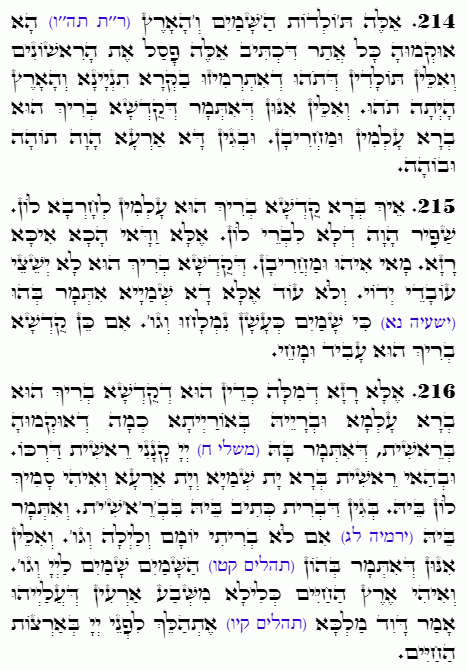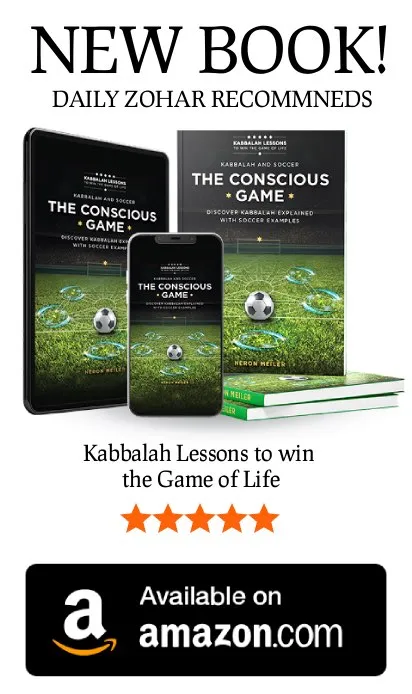Daily Zohar # 4684 – Beresheet – From chaos to perfect order
Daily Zohar 4684

Hebrew translation:
215. אֵיךְ בּוֹרֵא הַקָּדוֹשׁ בָּרוּךְ הוּא עוֹלָמוֹת לְהַחֲרִיבָם? יָפֶה הָיָה שֶׁלֹּא לִבְרֹא אוֹתָם! אֶלָּא וַדַּאי כָּאן יֵשׁ סוֹד. מַה זֶּה וּמַחֲרִיבָן? שֶׁהַקָּדוֹשׁ בָּרוּךְ הוּא לֹא יַשְׁמִיד אֶת מַעֲשֵׂי יָדָיו, וְלֹא עוֹד, אֶלָּא זֶה הַשָּׁמַיִם שֶׁנֶּאֱמַר בָּהֶם (ישעיה נא) כִּי שָׁמַיִם כֶּעָשָׁן נִמְלָחוּ וְגוֹ’. אִם כֵּן, הַקָּדוֹשׁ בָּרוּךְ הוּא עוֹשֶׂה וּמַכֶּה?!
216. אֶלָּא סוֹד הַדָּבָר, כָּךְ הוּא שֶׁהַקָּדוֹשׁ בָּרוּךְ הוּא בָּרָא אֶת הָעוֹלָם וּבָרָא אוֹתוֹ בַּתּוֹרָה, כְּמוֹ שֶׁבֵּאֲרוּהָ בְּרֵאשִׁית, שֶׁנֶּאֱמַר בָּהּ (משלי ח) ה’ קָנָנִי רֵאשִׁית דַּרְכּוֹ. וּבָרֵאשִׁית הַזּוֹ בָּרָא אֶת הַשָּׁמַיִם וְאֶת הָאָרֶץ, וְהוּא סָמַךְ אוֹתָם בָּהּ, בִּגְלַל שֶׁבְּרִית כְּתוּבָה בּוֹ בִּבְ’רֵ’אשִׁי’ת’, וְנֶאֱמַר בָּהּ (ירמיה לג) אִם לֹא בְרִיתִי יוֹמָם וָלָיְלָה וְגוֹ’. וְאֵלּוּ הֵם שֶׁנֶּאֱמַר בָּהֶם (תהלים קטו) הַשָּׁמַיִם שָׁמַיִם לַה’ וְגוֹ’. וְאֶרֶץ הַחַיִּים הִיא כְּלוּלָה מִשֶּׁבַע אֲרָצוֹת, שֶׁעֲלֵיהֶם אָמַר דָּוִד הַמֶּלֶךְ (שם קיו) אֶתְהַלֵּךְ לִפְנֵי ה’ בְּאַרְצוֹת הַחַיִּים.
.
Zohar Beresheet
Continued from previous DZ
#214
“אֵלֶּה תּ’וֹלְדוֹת הַ’שָּׁמַיִם וְ’הָאָרֶץ” (initials תֹּהוּ, Tohu) “These are the generations, etc.” (Genesis 2:4). This has already been explained: Wherever it says “These” (אֵלֶּה), it negates the previous ones. These generations refer to the worlds of תֹּהוּ Tohu (means chaos), which are hinted at in the verse, “וְהָאָרֶץ הָיְתָה תֹהוּ” “and the earth was formless and void” (Genesis 1:2).
“These are the generations, etc.”: It is said in various places that whenever the word “These” (אֵלֶּה) appears, it dismisses what came before. In this instance, the term “These” negates the generations of Tohu, which emerged from Malchut that was governed by the attribute of strict judgment (Din), called Tohu. This is hinted at in the verse, “And the earth was formless and void” (Genesis 1:2).
And these(generations of Tohu are the ones of which it is said: “The Holy One, Blessed be He, created worlds and destroyed them.” This is why the earth was described as “Tohu” and “Bohu,” meaning it was chaotic because those worlds were destroyed. Regarding these generations of Tohu, it is said: “The Holy One, Blessed be He, created worlds and destroyed them.” (https://www.sefaria.org/Bereshit_Rabbah.9.2?lang=bi&with=all&lang2=en) Thus, the verse says, “And the earth was formless and void,”—indicating that the earth was in a state of chaos because these worlds were destroyed.
However, the generations of ‘These’ (אֵלֶּה), which refer to Malchut sweetened by the attribute of mercy, were sustained. This is why the verse says “These” (אֵלֶּה)—to negate the earlier, chaotic generations.
Notes:
The Zohar teaches that the world’s creation went through stages, including phases of destruction, because the initial worlds were based purely on strict judgment. The current creation, however, endures because it is a balanced combination of judgment and mercy, allowing it to exist in harmony. The word “These” (אֵלֶּה) marks this shift from chaos (Tohu) to order, negating the earlier chaotic generations and establishing a new, sustainable creation.
#215
The question is raised: Why did the Holy One, Blessed be He, create worlds in the first place only to destroy them? Wouldn’t it have been better not to create them at all? But certainly, there is a secret here. What is the meaning of “and destroyed them”? For God does not let His handiwork go to waste. Surely, there is a deeper secret here, because what does it mean by “וּמַחֲרִיבָן” “and destroyed them”? Doesn’t God preserve His creations rather than destroy them? Moreover, it is written regarding the heavens: “כִּי שָׁמַיִם כֶּעָשָׁן נִמְלָחוּ” “For the heavens will vanish like smoke” (Isaiah 51:6), which seems to imply that God creates and then erases what He made, as one might expect from human beings but not from the Holy One, Blessed be He.
Notes:
The concept of God creating and destroying worlds is not to be understood in a literal, human sense. Instead, it reflects a deeper, hidden process in which the initial stages of creation are necessary but incomplete, and their “destruction” allows for the final, perfected creation to come into being. This cyclical process of creation and dissolution is a fundamental aspect of the Creator’s plan, not a mistake or failure, but a reflection of the deeper wisdom embedded in the unfolding of the universe.
#216
This is the secret of the matter: The Holy One, Blessed be He, created the world and did so through the Torah. As it has been explained, “בראשית” “in the beginning” refers to the Torah, about which it is said, “יְהוָה קָנָנִי רֵאשִׁית דַּרְכּוֹ קֶדֶם מִפְעָלָיו מֵאָז.” “YHVH acquired me at the beginning of His way” (Proverbs 8:22). Thus, the Torah calls itself “רֵאשִׁית” (beginning), and with this “רֵאשִׁית”—that is, the Torah—He created the heavens and the earth. This refers to the upper heavens and earth, which are the upper six Sefirot of Binah, and they are hinted at in the word Beresheet, in the secret of “ברא-שית” (created six).
He supported them with the Torah, as it is written in Beresheet (Genesis 1:1), where “בְּרֵאשִׁית” “Beresheet” contains the word “ברית” “Brit” (covenant). Bereshit is an acronym for “ברית-אש” or “Brit Esh” (covenant of fire). About this, it is said,
Jeremiah 33:25
“כֹּה אָמַר יְהוָה אִם לֹא בְרִיתִי יוֹמָם וָלָיְלָה חֻקּוֹת שָׁמַיִם וָאָרֶץ לֹא שָׂמְתִּי.”
“Thus says YHVH: ‘If My covenant is not with day and night, I would not have established the laws of heaven and earth.”
Thus, the heavens and the earth depend on the Torah, for their existence is sustained by the Brit within Beresheet, which is the Torah.
And regarding the heavens that were created and stand upon the Torah, it is said, “הַשָּׁמַיִם שָׁמַיִם לַה'” “The heavens are the heavens of YHVH” (Psalms 115:16). The earth, which was created and stood upon the Torah, is called “אֶרֶץ הַחַיִּים” “Eretz HaChayim,” and it is composed of seven lands. Concerning these seven lands, King David said,” אֶתְהַלֵּךְ לִפְנֵי ה’ בְּאַרְצוֹת הַחַיִּים” “I will walk before YHVH in the lands of the living” (Psalms 116:9). They are called the lands of the living to indicate that they are from Binah, which is called Elokim Chayim (the Living God). These heavens and earth belong to Binah, as explained above.
Notes:
The world was not only created by God but through the Torah, which is seen as the foundational blueprint. As spiritual concepts, the heavens and the earth are sustained by the Brit (covenant) embedded in the Torah. The earth itself is understood as Eretz HaChayim, a realm rooted in the level of Binah. This interconnectedness between the Torah, the covenant, and creation reflects the deep spiritual structure of the universe, according to the Zohar.
{||}

 Previous: Beresheet
Previous: Beresheet

